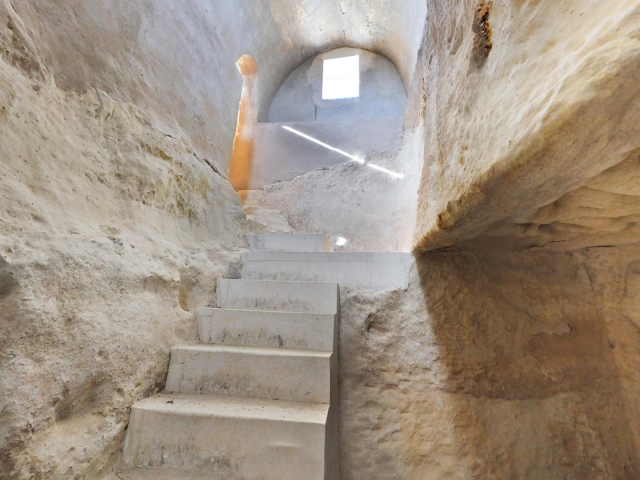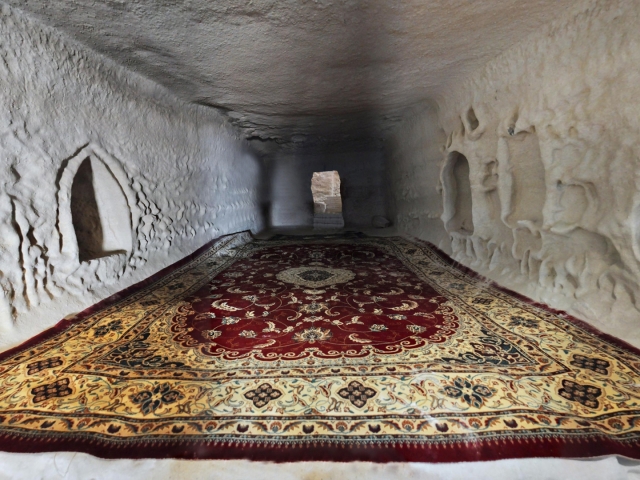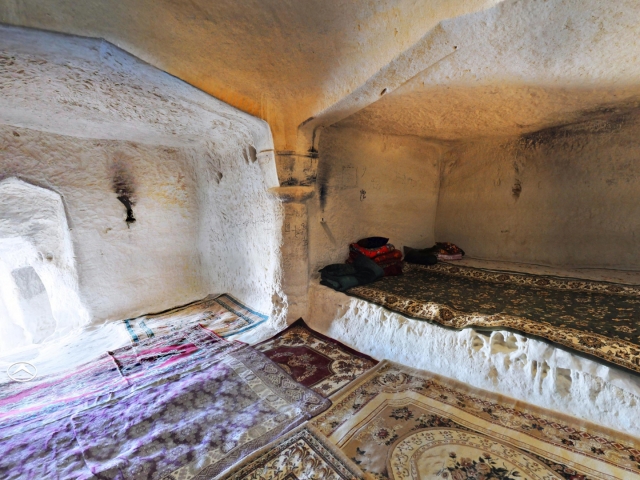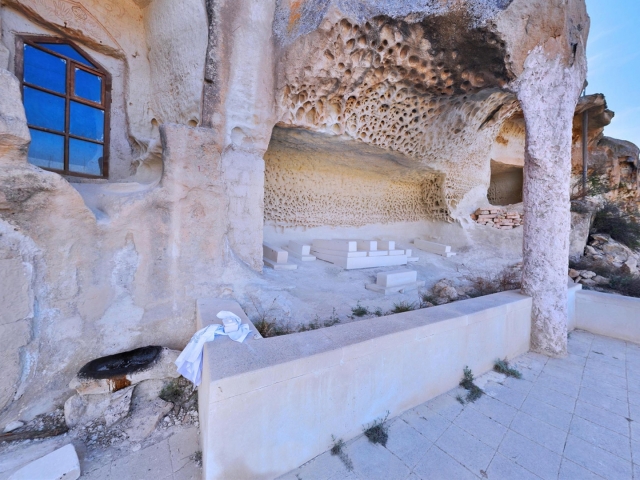Places
List of objects included in the map
Shakpak Ata Necropolis and Underground Mosque (14th–19th centuries)
Location: located in Tupkaragan district, Mangistau region, 30 km to the north-west of Tauchik village.
Coordinates: N 44°26' 2.29" , E 51°8' 10.08"
Description of the Monument: The mosque was first surveyed by a comprehensive expedition of the Satpayev Geological Institute of the Science Academy of the Kazakh SSR in 1965 through 1968 under the leadership of A. Medoyev. Later in 1973 it was studied by expeditions of the Polytechnic Institute and the Central Council of the Society for Protection of Cultural Sites of the Kazakh SSR under the direction of M. Mendikulov, and expeditions of the Ministry of Culture in 1976 under the leadership of A. Issenov and in 1979 under the direction of M. Nurkabayev. Resolution of Mangystau Akimat no. 414 dated 08.12.2010 approved the boundaries of the protected areas of the monument. In 1983 and 2014 experts of 'Mangystaurestavratsiya' did research and restoration works at the monument. The monument was first taken under the state protection with republican value category upon Resolution no. 38 by the Council of Ministers of the Kazakh SSR dated 20.01.1982. Later Resolution of the Government no. 279 dated March 21, 2008 was amended; by order of the Minister of Culture and Sports of the Republic of Kazakhstan no.119 dated March 30, 2015 the site was included in the governmental list of historical and cultural monuments of the republican value. Shakpak Ata mosque is the only monument in the Aral-Caspian region, on the walls of which there are inscriptions and drawings. According to geologist A. Medoyev 'The mosque in the rock has a complex architecture and is a magnificent spectacle of rare stone art in Kazakhstan'. Rock mosque Shakpak Ata is cut in the western slope of the plateau at high elevation in the limestone rock. The mosque has four rooms, chambers, grouped crosswise around the central room with a dome roof. The long axis of the mosque is oriented along east - west line. At the ends of this axis door openings are arranged. The front doorway at the western end is arranged like a small corridor, at the end of which, there is a small area; outer side of the opening is designed as a portal. In the crossing there is a central room with a hemispheric dome. The four corners of the central square hall are decorated with semicolumns, the decor of each of them is not repeated on the other. In the center of the dome a skylight is made with diameter of 1.2 m and a height of 5 m. A portal niche of the main door is a triangular arch. On the lower left and right of the entrance there are burial niches, reinforced from underneath with retaining walls. Outside above the arch a square pavilion (rotonda) was built with the walls orientated strictly in the cardinal directions which protected from rain and served a tower and minaret. This building has four window openings, one on each side, with pointed arched ends functioning as a lantern. The time of construction of the monument refers approximately to the early Middle Ages, in particular, M. Mendikulov dates the construction of the mosque approximately 14th-16th centuries during the reign of the Golden Horde by Khan Uzbek (1312-1342). To the west from the mosque Shakpak Ata there is the eponymous medieval necropolis. The territory of the necropolis is divided into the southern Turkmen and northern Kazakh part with their typical monuments mainly presented by staele and kulpytasses. In both parts of the necropolis there are both ancient and later tombstones, partially marked with tribal tamgas. The most interesting in terms of architecture and arts are the monuments of the 18th-19th centuries and the beginning of the 20th century belonging to the Kazakh part. They are mainly koytasses, kulpytasses, tomb chests and saganatams. At the necropolis there is a tomb of famous historical figure, preacher Yerzhan Hazret (Yerzhan Tulekenuly - 1888-1967) from Bektemis tribe of Adai clan who got higher religious education in Bukhara madrasah and Istanbul University. In 2008 in the framework of the regional program 'Madeni Mura' and to prepare a series of monuments in Mangistau to be included archaeological excavations, topographical, comprehensive engineering studies, architectural, ethnological research and survey of the protected zone of the underground mosque and necropolis of Shakpak-Ata and its surroundings were carried out (action by A. Astafyev, M. Kalmenov, Ye. Khorosh, L. Bisembiyeva, etc.). In 2009, within the framework of the regional program 'Cultural heritage' specialists of Suleimenov Institute of Oriental Studies studied Arabic graphic inscriptions and published the book 'Epigraphy of Shakpak Ata Underground Mosque and Necropolis' Shakpak-Ata mosque is the only monument in the Aral-Caspian region which walls are covered with inscriptions and drawings. Inscriptions are in Arabic, Turkic-Chagatai and Farsi languages; they suggest that the mosque was a sacred place, and a Sufi dwelling. A large part of the texts are of visiting nature. Here are the notes of visitors from Haji-Tarkhan (the former name of Astrakhan), Kazan, Azerbaijan, Khorezm, Bukhara and Andizhan. The earliest date of visits found in the inscriptions refers to 1707-1708. Visitors often indicated their tribe – Arabadji, Zhary, Taz, Turkmen-Adai. On the walls of the mosque and burial niches there are images of equestrian warriors and archers, horses, a cheetah, lotus blossoms and a bare palm. Sufs considered the image of a palm a talisman protecting a sacred place and everyone coming in here from incoming from the evil spirit.
Historical Data, Legends and Stories: Researchers could not accurately determine the time of life and death of Shakpak-Ata, a religious preacher, who deeply studied all Muslim canons, trained a lot of disciples, followers, educated children. One can only assume that this is the early Middle Ages. Well-known geomorphologist Serikbola Kondybay found that in myths Shakpak Ata is the master of snakes and patron of the dead, but as a historical figure he is grandson of Shopan Ata. According to legend, the real name of Shakpak-Ata was Shahmardan. Shakpak Ata is not the name of the founder of the mosque, but the nickname given to him because in battles with enemies sparks were flying from his weapon like from flint - shakpak-tassa. This caused panic among the enemy, and they fled from the battlefield. Its distinctive feature is that in the area of Shakpak Ata there are a lot of outputs of silicic rocks that could be one of the reasons for the legend. According to another version of the legend, Shakpak Ata could strike fire by touching one nail to another. Another legend says that Shakpak Ata was walking by a village and witnessed a husband beating his wife. The conflict was caused by the fact that there were no children in the family. Shakpak Ata immediately helped the woman. The woman followed Shakpak Ata, thereby she possibly wanted to express gratitude or did not want to bear ill-treatment from her husband. After they stopped in the desert springs came from the ground, a shower rain started and the life was renewed. After this, people began to come to this place from all over the world looking for help to get rid of their problems.
Sources:
1. Legends of the Adais about the Lived and Died Holy Hanafiyah Sects in Mangyshlak. // Collection of Data about the Mountain Peoples of the Caucasus. 7 issues. Tiflis, 1873;
2. 'Holy Places of Mangistau and Ustyurt' Serikbol Kondybai. 'Arys' 2007;
3. 'Underground Mosques in Mangistau' M. Kalmenov, O. Koshbaiuly - Almaty, Orkhon 2010;
4. Archives of Mangystau National Historical and Cultural Reserve, KPPM-229 (Passport of the monument).
Views: 6774
Video
3D Модель
Маршрут
Hazret Yerzhan Burial
Shopan Ata Necropolis and Underground Mosque
Khatam-Ishan Mausoleum
The earliest structures here date back to the second half of the 17th c. The necropolis was developed in time and space in a circle, i.e. the most ancient constructions remained in the center. Out of the two extant domed mausoleums, the structure in the southern part of the necropolis is of particular interest. ...
















